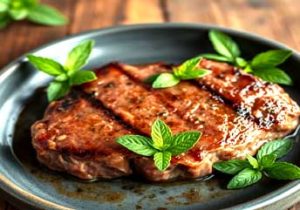Let’s be real. Steak gets a bad reputation.
The truth is, the healthiest steak to eat can be part of a balanced lifestyle—if you know what to look for. That’s why this guide breaks down exactly what makes a steak healthy, and which cuts you should actually be putting in your cart.
People often assume it’s loaded with saturated fat, harmful for your heart, and off-limits if you’re trying to lose weight or eat clean. However, here’s the twist most don’t know: not all steak is unhealthy. In fact, some cuts are surprisingly lean, packed with nutrients, and even helpful for building muscle and maintaining a healthy diet.
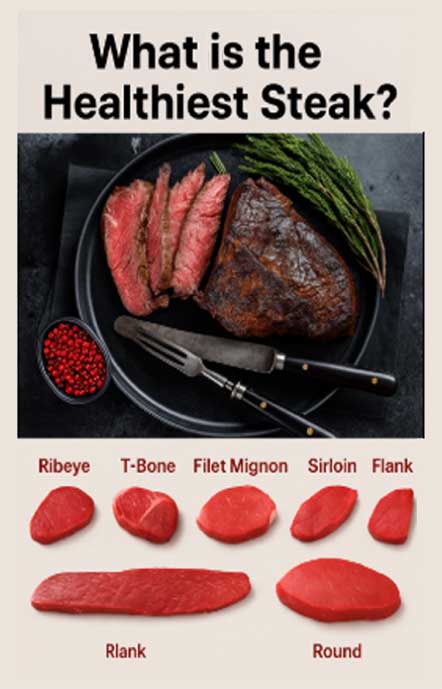
The Real Benefits of Steak (When You Choose the Right Cut)
When you strip away the myths, steak has a lot going for it. It’s not just a source of protein—it’s a powerhouse of essential nutrients. More importantly, the key is choosing lean, well-sourced cuts and knowing how to prepare them.
Here’s why steak can be a smart choice for your health:
High-Quality Protein
Steak is rich in complete protein, meaning it contains all nine essential amino acids. This supports muscle repair, fat burning, and helps you stay full longer—which is especially useful if you’re aiming for weight loss or muscle gain.
Iron That Works
Unlike plant-based iron, the iron in steak is heme iron, which your body absorbs more efficiently. Iron helps move oxygen through your blood, supports energy levels, and strengthens your immune system.
Brain and Immunity Boost
Lean steak is a top source of vitamin B12 and zinc. While B12 supports brain and nerve health, zinc helps fight off illness and supports skin health and wound healing.
Naturally Low-Carb
If you’re following a low-carb or keto plan, steak fits in naturally. Many of the healthiest steak cuts are low in fat and contain no carbs at all. That’s a major win for anyone watching their carb intake.
Healthy Fats (in Moderation)
Certain cuts of beef, especially grass-fed ones, contain small amounts of CLA (conjugated linoleic acid) and omega-3 fatty acids—healthy fats linked to reduced inflammation and better heart health.
What Actually Makes a Steak Healthy?
Not all steaks are equal. The fat content, calorie count, and nutrient profile can vary a lot depending on the cut. So what should you look for?
Let’s break down what separates a healthy steak from one that’s better left for special occasions.
Low Saturated Fat
The leanest steak cuts have little visible fat and minimal marbling. Less marbling usually means lower saturated fat, which can reduce the risk of heart disease.
Pro tip: Cuts with names like “round,” “loin,” or “sirloin” are usually leaner.
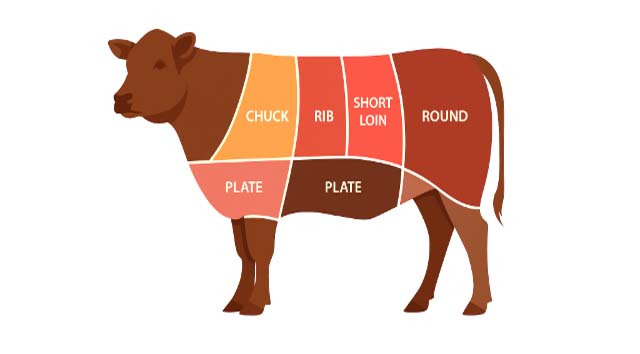
High Protein, Low Calorie
Look for steak that gives you the most protein for the fewest calories. In other words, you want more nutritional value in every bite, making it ideal for weight loss or clean eating.
Nutrient Density
The healthiest steak cuts are high in B12, iron, zinc, and selenium—all important for overall health and energy. These nutrients are hard to find in the same quantity from plant-based sources.
Grass-Fed Options
Grass-fed beef tends to be leaner and often contains more omega-3s and antioxidants. Additionally, it’s free from added hormones and antibiotics, which makes it a healthier and more sustainable option in many cases.
Key Terms to Know When Buying Steak
When you’re browsing the meat section, these are the labels and terms to watch for:
-
“Sirloin” or “Round”: Leaner, lower-fat options
-
“Grass-Fed”: Higher in nutrients and healthy fats
-
USDA Grades: “Select” and “Choice” are leaner than “Prime”
-
“Heart Smart”: Usually meets specific fat and cholesterol criteria
Final Word for This Section
If you’ve been avoiding steak because of outdated health myths, it’s time to reconsider. The healthiest steak to eat is not only delicious, but also packs in nutrients that support your energy, muscle recovery, and long-term wellness. The key? Choosing lean cuts, being mindful of portions, and using healthier cooking methods.
Next, we’ll take a closer look at the best cuts of steak ranked by nutrition so you can make smart choices every time.
Top 7 Healthiest Cuts of Steak (Ranked with Nutritional Data)
Most people assume that the fancier or more expensive the steak, the healthier it must be. However, that’s not exactly true.
In reality, some of the leanest and most nutritious cuts are not only budget-friendly, but they’re also easy to cook and widely available. Therefore, when it comes to figuring out what is the healthiest steak to eat, you’ve got to go beyond price tags and trendy steakhouse menus.
Below, we’ll walk through the seven best steak cuts for your health—ranked by calorie count, protein content, fat levels, and how well they fit into clean eating.
1. Top Sirloin
First on the list is top sirloin. While it may not have the buttery richness of ribeye, it’s much leaner and packs a solid nutritional punch. Plus, it’s super versatile.
-
Low in saturated fat
-
High in protein per gram
-
Ideal for grilling, broiling, or slicing into salads
Why it’s a winner: It provides great flavor and texture with less fat than most cuts. Additionally, it’s affordable and easy to cook.
Best for: High-protein diets, daily clean eating
2. Eye of Round
Next up is the eye of round—a cut many people skip over. Yet it’s one of the leanest beef cuts available, which makes it a smart choice if you’re watching fat intake.
-
Extremely low in total fat
-
High in protein
-
Needs slow cooking or tender slicing for best results
Why it matters: It’s significantly lower in calories and fat than popular steaks like T-bone or ribeye. Because of that, it’s great for fat loss.
Best for: Weight loss, heart-smart eating plans
3. Top Round (London Broil)
Also known as London Broil, this steak is another lean cut worth trying. Although it’s a bit tougher than others, it’s excellent when marinated.
-
Lean and high in protein
-
Should be cooked medium-rare or sliced thin
-
Common in meal prep recipes
Why it’s healthy: It’s great for large portions without blowing your fat or calorie budget. Plus, it’s very budget-friendly.
Best for: Weekly meal prep, family meals
4. Flank Steak
If you’re after a lean steak with a ton of flavor, flank steak is a strong contender. While it’s naturally low in fat, it’s also super tasty—especially with a good marinade.
-
High in protein
-
Low in saturated fat
-
Excellent for grilling or broiling
Why it’s impressive: Not only does it work for muscle-building, but it’s also ideal for low-fat diets.
Best for: Fitness goals, flavor-focused eating
5. Tenderloin (Filet Mignon)
Although this cut is pricier, it’s also one of the leanest and most tender options you’ll find. Furthermore, it’s naturally low in fat and easy to digest.
-
Minimal marbling
-
Incredibly tender
-
Great for pan-searing or grilling
Why it’s useful: It’s ideal for special occasions when you still want to eat clean.
Best for: Heart-healthy diets, occasional indulgence
6. Bottom Round
Bottom round is very similar to top round, but slightly more affordable. While not as tender, it still qualifies as a healthy steak when prepared correctly.
-
Lean and protein-rich
-
Good for roasting and slicing
-
Great in stir-fries or meal prep bowls
Why it’s valuable: It gives you more bang for your buck without sacrificing nutrition.
Best for: Budget-friendly healthy eating
7. Chuck Shoulder (Lean Trimmed)
Although chuck is usually thought of as fatty, the shoulder portion, when trimmed, is surprisingly lean. Additionally, it works great in a slow cooker.
-
High in protein
-
Lean when trimmed properly
-
Great for shredded dishes or bowls
Why it belongs here: It’s accessible, affordable, and a good break from the usual cuts.
Best for: Slow cooking, variety in weekly meals
The Best Steak Cut for Your Goals
Now that we’ve covered the top steak options, let’s talk about something more specific—your health goals.
Because not everyone is trying to hit the same target, the best steak for you depends on your lifestyle, diet, and what you want from your meals.
If You Want to Lose Weight: Eye of Round
This cut is one of the lowest in both fat and calories. Therefore, it’s a great choice for reducing overall calorie intake while still getting lots of protein.
If You Want to Build Muscle: Top Sirloin or Flank Steak
These steaks offer more protein per gram without excess fat. Also, they’re easy to cook in bulk, which makes meal prep much easier.
If You Want Better Heart Health: Tenderloin or Grass-Fed Cuts
Both are low in saturated fat and often contain higher levels of omega-3s, especially if grass-fed. Because of that, they support heart health while still tasting great.
If You’re on a Keto or Low-Carb Diet: Flank, Sirloin, or Chuck
Lean doesn’t mean low-fat, and that’s a good thing if you’re aiming for fat-fueled energy. Just remember to pair these with healthy fats and non-starchy veggies.
If You Want an All-Around Healthy Meal Plan: Top Round or London Broil
These cuts are balanced, low in fat, and easy to work into regular weeknight meals. Moreover, they’re great for families or meal preppers.
Comparing Popular Steak Cuts: Which Is Healthier?
Let’s face it—most people don’t research their steak before buying. Instead, they grab whatever sounds familiar or whatever a restaurant labels as “premium.” But here’s what they don’t realize: the most popular cuts are not always the healthiest.
So if you’re wondering how ribeye stacks up against sirloin, or whether tenderloin is worth the hype, this section breaks it down for you—cut vs cut, health benefit vs health risk.
Nutritional Comparison of Popular Steak Cuts (per 100g)”
| Cut | Calories | Total Fat (g) | Saturated Fat (g) | Protein (g) | Best For |
|---|---|---|---|---|---|
| Eye of Round | 140–170 | ~4–5 | Low | 28–29 | Weight loss, low fat diets |
| Top Sirloin | 200–206 | ~10 | Moderate | 25–26 | High protein, muscle gain |
| Flank Steak | 190–192 | ~8 | Low | 28 | Keto, fitness diets |
| Tenderloin | 179 | 7 | Very Low | 26 | Heart health, clean indulgence |
| Top Round | 166 | 5 | Low | 29 | Meal prep, weight loss |
| Chuck Shoulder | 200+ | 9–12 (trimmed) | Moderate | 25 | Slow cooking, bulk meals |
| Ribeye | 291 | 21 | High | 23 | Occasional treat |
| T-Bone | 294 | 22 | High | 24 | Flavor-focused special meals |
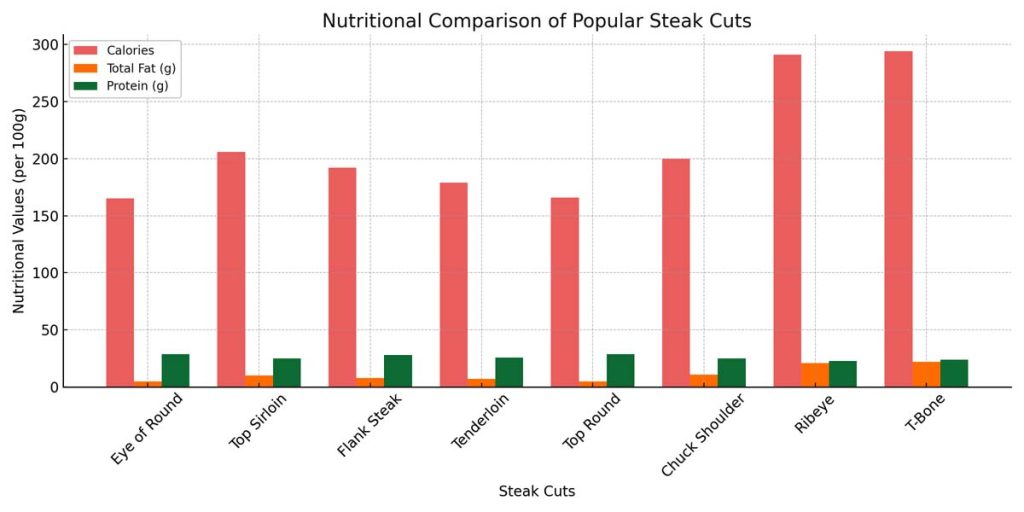
Sirloin vs Ribeye: Which One Should You Choose?
This is probably the most common steak showdown.
Ribeye is known for its marbling—aka visible fat. That makes it juicy, flavorful, and tender. However, it’s also one of the highest-fat steaks you can buy.
Sirloin, on the other hand, is much leaner. It still tastes great but doesn’t come with the same calorie or saturated fat load.
Nutritional snapshot per 100g:
-
Ribeye: 291 calories, 21g fat, 23g protein
-
Sirloin: 206 calories, 10g fat, 25g protein
Verdict: Sirloin wins for clean eating, weight loss, and heart health. Ribeye may be tastier for some, but it’s best reserved for cheat days.
Tenderloin vs Flank Steak: Lean Luxury or Functional Fuel?
Both of these cuts are lean, but they serve very different purposes.
Tenderloin (or filet mignon) is prized for its texture—it’s incredibly soft and elegant. It’s also low in fat but tends to be expensive and small in portion.
Flank steak is slightly higher in fat but more budget-friendly and protein-dense. It’s great for meal prep and large families.
Nutritional snapshot per 100g:
-
Tenderloin: 179 calories, 7g fat, 26g protein
-
Flank Steak: 192 calories, 8g fat, 28g protein
Verdict: If budget isn’t a concern and you want something tender, go with tenderloin. But for everyday meals and high-protein goals, flank steak wins.
T-Bone vs Top Round: Big Flavor or Smart Fuel?
T-Bone steaks are massive and full of flavor—thanks to the mix of tenderloin and strip steak. But they also come with high fat content and more calories.
Top round, meanwhile, is a leaner, tougher cut—but it’s much better if you’re focusing on macros and avoiding saturated fats.
Nutritional snapshot per 100g:
-
T-Bone: 294 calories, 22g fat, 24g protein
-
Top Round: 166 calories, 5g fat, 29g protein
Verdict: T-Bone is tasty but indulgent. Top round is ideal for clean eaters and meal preppers.
Grass-Fed vs Grain-Fed Steak: What’s the Healthier Choice?
There’s a lot of buzz around grass-fed beef. But is it actually better for your health—or just clever marketing?
Let’s break it down.
Nutritional Differences That Matter
Grass-fed cows eat a natural diet of grass. Grain-fed cows are usually raised on corn or soy, often in feedlots. As a result, grass-fed beef tends to be leaner and higher in omega-3 fatty acids, CLA (a healthy fat), and antioxidants like vitamin E.
Per 100g (typical values):
-
Grass-Fed: 140–170 calories, higher omega-3s, less total fat
-
Grain-Fed: 180–220 calories, more total and saturated fat
Why it matters: The difference in fat quality can impact inflammation, cholesterol, and heart health over time.
Antibiotics, Hormones, and What You Don’t See on the Label
Grass-fed beef is less likely to contain added hormones or antibiotics, which is important if you’re trying to reduce chemical exposure. Although not every grain-fed cow is given hormones, grass-fed systems typically avoid them entirely.
Plus, many grass-fed farms follow more humane and sustainable practices, which is better not just for your health—but also for the planet.
Which One Should You Buy?
If your goal is to eat the cleanest, most nutrient-rich steak available, grass-fed wins hands down. It’s not only better for your heart, but it also fits better with diets like paleo, clean eating, and anti-inflammatory protocols.
However, it does tend to be more expensive. So if you’re eating steak just once or twice a week, the extra cost may be worth it.
Verdict: For better fats, more nutrients, and fewer additives, choose grass-fed when possible.
Healthiest Ways to Cook and Eat Steak
You’ve picked the perfect cut. But here’s the part many people overlook—how you cook it makes a huge difference.
In fact, even the leanest steak can become unhealthy if it’s cooked the wrong way. Using heavy oils, burning the meat, or drowning it in sugary sauces? That’s how you ruin a good thing.
Let’s walk through how to cook your steak so it stays lean, flavorful, and nutrient-packed—without sacrificing taste.
Choose Smart Cooking Methods
Certain methods help preserve nutrients and minimize extra fat.
Best options for healthy cooking:
-
Grilling: Quick, high-heat cooking with minimal oil
-
Broiling: Similar to grilling but done in the oven
-
Pan-searing with healthy oil: Use avocado oil or extra virgin olive oil
-
Sous vide: Cooks steak evenly at lower temps, locking in moisture without overcooking
Avoid deep frying or cooking in butter-heavy sauces, as they add unnecessary fat and calories.
Don’t Overcook It
Not only does overcooking dry out your steak, but it can also destroy sensitive nutrients like B vitamins. Worse, it can produce harmful compounds like heterocyclic amines (HCAs) and polycyclic aromatic hydrocarbons (PAHs)—both linked to inflammation and cancer risk.
Stick to medium-rare or medium, especially with leaner cuts like top sirloin or eye of round. If you’re grilling, avoid charring.
Trim Visible Fat
Before cooking, take a minute to trim any visible fat. This simple step can significantly reduce saturated fat intake—especially for cuts that aren’t naturally extra lean.
Also, if you’re cooking ground beef or minced steak, be sure to drain the fat after cooking and blot the meat with paper towels.
Watch the Add-Ons
Steak on its own can be super healthy. But once you throw on butter, cream-based sauces, or cheesy toppings, that changes fast.
Instead:
-
Use spice rubs or fresh herbs like rosemary, garlic, or thyme
-
Add lemon juice or balsamic vinegar for flavor without calories
-
Pair steak with fiber-rich veggies or a whole grain for a complete meal
Practice Smart Portion Control
Even healthy steak should be eaten in moderation. A serving size is about 3–4 ounces cooked—roughly the size of your palm.
Eating too much red meat too often can increase your risk of certain health issues, especially if your overall diet is low in fiber and plant-based foods.
Aim for 2–3 servings per week, paired with vegetables, whole grains, or legumes.
How to Choose the Healthiest Steak at the Store
We’ve covered how to cook it, but let’s zoom out. Buying the right steak is just as important as cooking it right. And if you’re staring at 20 different cuts in the meat aisle, you’re not alone.
Here’s how to shop smarter—and healthier.
Know What the Labels Mean
Labels can be confusing. However, once you know what to look for, it’s much easier to spot the healthiest steak to buy.
Look for:
-
Grass-Fed: Higher in omega-3s, more nutrients, often free of hormones and antibiotics
-
USDA Select or Choice (not Prime): These grades are leaner, with less marbling
-
Lean or Extra Lean: Usually refers to total fat content—”extra lean” means less than 5g fat and 2g saturated fat per 100g
-
Organic or Hormone-Free: May be better for those wanting cleaner, more sustainable meat
Buy From a Trusted Source
Whenever possible, choose steak from:
-
Local butcher shops (they often trim to order)
-
Reputable organic or grass-fed farms
-
Trusted supermarket brands with third-party certifications
Bonus: Online meat delivery services often include detailed sourcing info and nutritional transparency.
Know What to Avoid
Skip steaks with:
-
Thick layers of visible fat
-
High marbling unless you’re going for flavor over health
-
Pre-seasoned or pre-marinated cuts with sugary or salty sauces
Also, be cautious of vague terms like “natural” or “all-natural”—they sound good but mean very little without certification.
Budget Tips for Healthy Steak Shopping
You don’t have to go broke eating well.
Try this:
-
Buy large, lean cuts (like top round) and slice them yourself
-
Shop sales and freeze portions for later
-
Choose less “popular” cuts (eye of round, bottom round) that offer great value and nutrition
How Often Should You Eat Steak?
Let’s clear up another common myth: eating steak regularly will wreck your health.
That’s not necessarily true.
In fact, eating lean, high-quality steak in moderation can support a healthy diet. The key is how much, how often, and what type of steak you’re choosing.
So… how often is “too often”? And what’s the sweet spot if you want the benefits without the risks?
Let’s break it down.
What the Science Says
According to the American Heart Association (AMH) and the Dietary Guidelines for Americans, lean red meat can be part of a heart-healthy diet—as long as it’s limited to 3–4 servings per week. That’s roughly 12–16 ounces of cooked steak total per week.
In other words, you can enjoy steak 2–3 times a week without guilt, especially if:
-
You choose lean or extra-lean cuts
-
And you use healthy cooking methods (grilling, broiling, sous vide)
-
You keep your portion sizes in check (about 3–4 oz per serving)
What Happens If You Overdo It?
If your diet is heavy on high-fat cuts (like ribeye or T-bone) and light on fiber-rich veggies, you might run into trouble. Too much saturated fat can raise LDL (bad) cholesterol levels and increase inflammation—especially when combined with low physical activity.
Moreover, consistently overeating red meat—particularly processed red meats like sausages and bacon—has been linked to a higher risk of heart disease and certain cancers.
So the takeaway is simple: balance and variety are key.
How to Make Steak Work for Your Lifestyle
Instead of cutting steak completely, try this:
-
Alternate your proteins: Mix steak with poultry, fish, legumes, or plant-based proteins throughout the week
-
Focus on fiber: Pair steak with fiber-rich veggies like broccoli, Brussels sprouts, or leafy greens
-
Stick to lean cuts: Choose top sirloin, eye of round, flank, or tenderloin
-
Eat it mindfully: Make steak a highlight—not the whole plate
Whether you’re following a high-protein diet, eating for performance, or just love a good steak, the healthiest approach is to enjoy it a few times a week and build your meals with whole-food balance.
Budget-Friendly Healthy Steaks (Without Sacrificing Nutrition)
Eating healthy doesn’t have to mean spending big—especially when it comes to steak.
While premium cuts like filet mignon and New York strip can be expensive, there are plenty of less trendy cuts that deliver big on nutrition without draining your wallet.
Here’s how to eat steak on a budget and still stick to your health goals.
Top Budget Picks for Healthy Steak Cuts
These are the most cost-effective, nutrient-dense cuts of steak you can buy right now:
-
Eye of Round
-
Super lean
-
Incredibly affordable
-
Great for slow cooking or thin-slicing
-
-
Top Round (London Broil)
-
High in protein, low in fat
-
Works well in marinades or bulk meal prep
-
Great for families
-
-
Bottom Round
-
Slightly less tender but still lean
-
Excellent in soups, stir-fry, or roast meals
-
-
Chuck Shoulder (Trimmed)
-
Often overlooked
-
Lean when trimmed properly
-
Ideal for shredded beef, tacos, or slow-cooked dishes
-
Pro Tips to Stretch Your Steak Budget
Even lean cuts can cost more per pound than chicken or turkey. So here’s how to stretch every dollar while still eating well:
-
Buy in bulk: Purchase larger cuts like top round and slice them yourself
-
Shop sales and freeze portions: Keep an eye on local deals and stock up when prices drop
-
Use steak as a flavor enhancer: Add thin strips to veggie bowls, salads, or whole grain dishes, instead of making it the main event
-
Explore store-brand grass-fed options: Many private-label brands now carry clean, lean steak at a lower price
When to Splurge (and Why It’s Sometimes Worth It)
While it’s smart to save, there are times when spending a little more can make a big difference—especially when it comes to quality and nutrition.
Consider upgrading when:
-
You’re buying grass-fed beef (for better fat quality)
-
You want to reduce exposure to hormones or antibiotics
-
You’re celebrating and want that extra-tender cut (like filet mignon)
It’s all about strategic splurging—spend where it counts and save where it doesn’t.
Advanced Cooking Hacks for Lean Steak Cuts
Here’s something no one tells you: lean steak doesn’t have to mean dry or tough. If you’ve ever made a healthy steak and ended up chewing like it was jerky… you’re not alone.
But the problem isn’t the steak — it’s the technique.
Here’s how to turn those ultra-lean cuts (like eye of round or top sirloin) into juicy, flavorful meals that don’t sacrifice health for taste.
Use a Marinade That Works
Leaner steaks don’t have as much fat to carry flavor or moisture. That’s where marinades come in.
The trick? Go beyond just oil and vinegar.
Add natural tenderizers, like:
-
Pineapple or papaya juice (rich in enzymes like bromelain and papain)
-
Greek yogurt (helps break down muscle fibers)
-
Citrus (like lemon or lime)
-
Low-sodium soy sauce or tamari for umami
Marinate for at least 2–4 hours, or overnight for tougher cuts like top round.
Master the Sous Vide Method
Sous vide is a game-changer for healthy steak. It allows you to cook lean cuts precisely at the perfect temperature so they stay juicy without overcooking.
Even eye of round or bottom round comes out tender when cooked sous vide for a few hours, then seared quickly in a hot pan for that golden crust.
Bonus: it’s one of the best cooking methods for nutrient preservation.
Try Reverse Searing
Here’s another pro technique: cook your steak slowly in the oven at low heat, then finish with a hot sear in a cast iron pan.
This is especially helpful for thicker, lean steaks that tend to dry out fast on the grill.
It gives you more control over doneness, keeps the steak tender, and adds a nice crust without burning or charring.
Slice It Thin, Against the Grain
If you’re eating top round, flank, or bottom round, how you slice matters just as much as how you cook. Always slice against the grain (the visible muscle fibers) to reduce chewiness.
Thin, angled slices make lean steaks feel more tender — even without a ton of fat.
Ethical and Environmental Considerations: What Healthy Steak Looks Like in 2025
It’s not just about what’s on your plate anymore. For more and more consumers, eating healthy also means making choices that are ethical, sustainable, and climate-conscious.
And yes, this absolutely applies to steak.
Grass-Fed and Regeneratively Raised: Why It Matters
Grass-fed beef isn’t just a nutrition win. It also often comes from smaller, more sustainable farms that prioritize:
-
Better land management
-
Animal welfare
-
Fewer antibiotics and hormones
Some producers take it further with regenerative agriculture, which helps rebuild soil health and reduce carbon emissions from livestock.
If you’re buying grass-fed, look for certifications like:
Local and Small-Scale Producers
When possible, buying from local farms or co-ops means:
-
Supporting smaller operations
-
Reducing food miles (aka carbon footprint)
-
Often gaining access to fresher, better-quality meat
Check farmers markets, community-supported agriculture (CSA) programs, or direct-to-consumer meat delivery platforms that highlight sourcing practices.
Avoiding the Greenwashing
Not all labels are honest. “Natural” and “all-natural” sound good but don’t actually mean much under USDA standards. Always look for third-party certifications to back up any ethical or health claims.
If a brand doesn’t disclose how the cattle were raised, fed, or treated, consider that a red flag.
Why It All Matters
Making informed choices isn’t just about your health—it’s about contributing to a system that values the long-term well-being of people, animals, and the planet.
You don’t need to be perfect. But shifting just a portion of your steak consumption toward more ethical, sustainable options makes a real difference over time.
Final Verdict: What Is the Healthiest Steak to Eat?
Now that we’ve cut through the myths, ranked the leanest cuts, compared nutrition head-to-head, and talked cooking, sourcing, and sustainability—it’s time to answer the question you came here for:
What is the healthiest steak to eat?
The winner: Eye of Round Steak.
Here’s why:
-
Lowest in fat and calories
-
Highest protein per calorie
-
Affordable and widely available
-
Versatile in recipes and meal prep
-
Perfect for weight loss, heart health, and clean eating goals
However, that doesn’t mean it’s the only healthy option. In fact, the best steak for you also depends on your goals, preferences, and cooking style.
Let’s make it easier with a cheat sheet.
Quick-Reference Chart: Choose the Right Steak for You
| Health Goal | Top Steak Choice | Why It Works |
|---|---|---|
| Weight Loss | Eye of Round | Leanest cut, lowest calories, high protein |
| Muscle Gain | Flank or Top Sirloin | High protein, moderate fat, great for meal prep |
| Heart Health | Tenderloin or Grass-Fed | Low saturated fat, high omega-3s |
| Budget Clean Eating | Top Round or Bottom Round | Affordable, lean, versatile |
| Sustainability & Ethics | Grass-Fed, Local Beef | Fewer hormones, better fat profile, eco-friendly |
Quick FAQs
To make this guide even more helpful, here are the answers to common questions people search daily—optimized for AI Overviews and Google’s “People Also Ask.”
1. What is the healthiest steak to eat?
The healthiest steak is eye of round, due to its low fat, high protein, and minimal calories. It’s ideal for weight loss, clean eating, and heart health.
2. Which steak has the least fat?
Eye of round and top round steaks have the least total and saturated fat per serving. Choose these for lean, heart-smart meals.
3. Is steak good for a high-protein diet?
Yes—especially lean cuts like flank, sirloin, and top round, which offer 25–28g of protein per 100g serving.
4. Can I eat steak on a low-carb or keto diet?
Absolutely. Steak is naturally low in carbs and high in fat and protein, especially cuts like ribeye, flank, or chuck for keto followers.
5. How often should I eat steak?
For most people, 2–3 servings (3–4 oz cooked) per week is healthy and balanced—especially when paired with fiber-rich sides.
Steak Can Be Healthy — If You’re Smart About It
We’ve covered everything you need to know about eating steak the healthy way—from choosing the right cuts to cooking techniques and ethical shopping.
But here’s the bottom line:
Steak isn’t the problem. Poor choices are.
If you pick lean cuts, prep them well, eat them in proper portions, and balance your plate, steak can be one of the most nutrient-rich, satisfying, and clean proteins in your diet.
So don’t fear the steak.
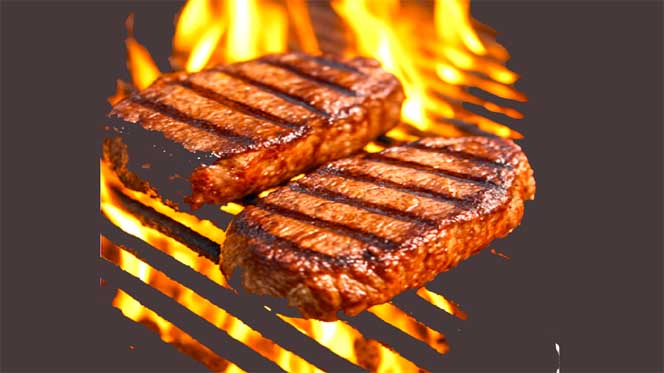
Website References:
Here are 10 useful website links to help you about lean beef nutrition, healthy steak cuts, or grass‑fed benefits—perfect for looking to dive deeper into “the healthiest steak”:
-
Mayo Clinic – Cuts of Beef: A Guide to the Leanest Selections
https://www.mayoclinic.org/healthy-lifestyle/nutrition-and-healthy-eating/in-depth/cuts-of-beef/art-20043833 Mayo ClinicMayo Clinic News Network+6Mayo Clinic+6Mayo Clinic+6 -
Mayo Clinic – Grass‑Fed Beef: What Are the Heart‑Health Benefits?
https://www.mayoclinic.org/diseases-conditions/heart-disease/expert-answers/grass-fed-beef/faq-20058059 Mayo Clinic -
USDA FoodData Central (Official Nutrient Database)
https://fdc.nal.usda.gov/food-search/?type=Foundation FoodData Central+12FoodData Central+12Wikipedia+12 -
USDA FoodData Central (About & Documentation)
https://fdc.nal.usda.gov/ FoodData Central+12FoodData Central+12FoodData Central+12 -
Mayo Clinic Connect – Choosing Lean Cuts of Meat
https://connect.mayoclinic.org/blog/take-charge-healthy-aging/newsfeed-post/choosing-lean-cuts-of-meat/ Mayo Clinic Connect+10Mayo Clinic Connect+10Mayo Clinic+10 -
USDA FoodData Central: SR Legacy & Foundation Foods Documentation
https://fdc.nal.usda.gov/docs/Foundation_Foods_Documentation_Apr2024.pdf FoodData Central+7FoodData Central+7Wikipedia+7 -
USDA FoodData Central: Global Branded Food Products Database Guide
https://fdc.nal.usda.gov/docs/Branded_Foods_Documentation_Apr2024.pdf FoodData Central+7FoodData Central+7Wikipedia+7 -
USDA FoodData Central API Spec (for developers)
https://fdc.nal.usda.gov/api-spec/fdc_api.html FoodData Central+12FoodData Central+12FoodData Central+12 -
Mayo Clinic News – Meat Myths: Red vs White Meat for Heart Health
https://newsnetwork.mayoclinic.org/discussion/mayo-clinic-minute-meat-myths-%E2%8F%A4-red-vs-white/ Mayo Clinic+4Mayo Clinic News Network+4Mayo Clinic News Network+4 -
Mayo Clinic News – Are You Getting Too Much Protein?
https://newsnetwork.mayoclinic.org/discussion/are-you-getting-too-much-protein/
Disclaimer: The content on this website is intended for informational purposes only and should not be taken as medical advice. Always consult with a qualified healthcare professional for personalized guidance regarding your health needs.



